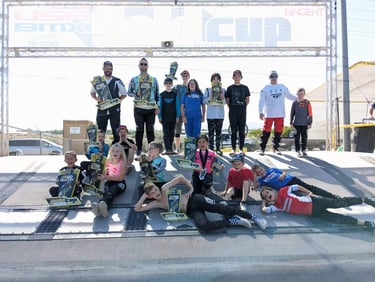The Cost of BMX Racing
Why are we (mainly me) writing this? Because we want prospective riders and parents to know what they are getting into with BMX racing. It takes passion, dedication, training, willpower, and focus. And time and money.
Buy a freestyle/park bike and grind it, jump it, and hop it at the skatepark or on the streets for free. Go get a mountain bike and shred the gnar for free, or pay to use purpose-built bike parks all day. Buy a road bike and race around the roads for free, dodging cars along the way (roadies get no love). Buy a BMX race bike, and nothing is free. I'm going to tell it like it is. This is based on our experience, observations, and being in the BMX race community. Try to read this to the end.
First, let's talk about bikes and parts in general. If you have any type of bike meant for cycling sports then upgrading and maintaining go with it. That costs money whether it's a park, race, MTB, road, or gravel bike. The post-covid oversupply with rock bottom prices and lots of inventory from a few years ago is gone. Cycling is back to low demand, low volume, and higher prices. There's still deals to be found, but overall things aren't getting cheaper. BMX racing is a niche of a niche. The post-covid cycling collapse also hastened the disappearance of brands and parts as companies don't like to spend $100 to make $10. To avoid a class in economics, let's just say market conditions aren't good for the cycling industry which affects prices. Used market aside, as that follows its own local trends.
BMX racing is not a 'drop-off' sport. There are no coaches to watch your kid. You might have to volunteer to score, drop gates, work a corner, or help run the race. The track has to be maintained as well, and it is volunteers that do it. BMX racing is the parents as much as it is the kids. You don't have to take over or be an all-star at anything. Working a corner means watching it for safety. Scoring is writing down the bike numbers as they cross the finish line. Nothing difficult, and each volunteer is very important. BMX racing is not compatible with dropping your racer off and then having 'me time' across town. Many times, BMX is not even a spectator sport. Everyone is involved. If you're an adult racer, switch the word parent for spouse... wives, this is not a drop off sport; your 'man-child' needs someone to drive him to the ER and have sympathy for him after crashing. BMX racing is not a babysitter. You'll need to be there. A kid's success is tied to the parents' involvement. It will cost you your time.
The BMX race leagues are fun. They are a great introduction to the track and using BMX race bikes and gear. Your one-time league fee gets you coaching, mock races, gear usage, and a pizza party. It's basically fun intramural sports. The fee usually comes with a paid membership to USA BMX too. Racing and league are not the same. The fun line gets distorted. Coming from the leagues into racing makes leagues look like bait-and-switch. BMX racing is an individual sport like track, golf, or swimming. It's not like traditional ball sports. For example, your kid can hit but not throw, his teammate can throw but not hit, and another can catch anything; together they win the tournament. If you think of BMX racing as baseball then your kid will need to hit, throw, catch, and run. Bob Ross once said, "Talent is a pursued interest." BMX racing is a talent that must be pursued. The rider that races here and there when they feel like it isn't going to go far in BMX. It takes determination and dedication. Getting last place is also part of racing. It is important to have a mindset of you're not losing, you're learning. The fun comes and goes, and passion and determination must be the driver. Pursue it and you will get faster and better. You're always learning, never losing. Winning is fun, and winning takes work. We've seen kids with expensive personal coaching programs, and we've seen kids ride every day and figure it out as they go. Both are putting in the work, and we've seen both win over the other. Each individual is different in how they train to get results. Put in the work and be proud that you are doing what few will do. Success is not quitting. Riding fast with 8 others on a track isn't a skill that we are programmed with. It takes practice. Which leads to this: racing is dangerous. Some age and skill groups are more dangerous than others, but the element of danger is always there. I know kids that do wrestling, football, and hockey and they tell me BMX is the sport they get hurt in. It is classified as an extreme sport after all. The majority of injuries are just scrapes and bruises, but the percentage of breaks, tears, sprains, and concussions are higher than other sports. Olympic BMX racing is the most dangerous bicycle sport according to UCI studies. More than downhill mountain biking. I have a helmet mounted Go-Pro video of a crash where one of my team riders inadvertently rides over another rider's wrist, breaking it. In that same crash another rider was badly concussed but pure adrenaline got him up, got him across the finish line, and 20 yards beyond that he collapsed unconscious. It's hard to say how tough your kid is but make sure they have a good helmet and insurance. I try not to think about this aspect of the sport. Still with me?
You need the right bike for BMX racing. Modern BMX racing is a technical sport requiring technical equipment. Your first bike may cost anywhere from $250 to infinite and beyond. If you find the '100 dollar special' it will need $100+ of work. For young riders be prepared to buy a bike, parts, or frame every year. Up until they are teens it's typical for kids to get 1 or 2 seasons out of a bike. Usually, parts can be transferred to the next frame size to help keep costs down, but parts also wear out. You'll go through a lot of tubes, and some are special sizes used only on BMX race bikes. Some tires last six months, some last years. Tires aren't cheap. Grips wear out fast. You get the point. The good thing is your BMX race bike is rebuildable. Many of the race bikes buy and sell amongst BMX'ers so you know what you're getting. Our advice is to use the track bikes until you are certain BMX racing is what you and your kid want to do. As the rider gains skills, they will need better equipment. Better costs money. The expensive bikes cost more money to maintain too. Riders can start in a Ford, but eventually they're going to need a Ferrari. Helmets can cost anywhere from $50 to $700. A basic full-face helmet works to start out, but eventually you'll need to buy a better helmet. Racewear is another cost. Sure, a pair of pants and long sleeve are all that is required, but riders want to look good. Jerseys can be from the closeout bin or the newest releases. Pants can be athletic joggers or purpose made for bike racing. Van's or gummy sole flat pedal shoes from 5.10 or RC. It just depends on what you want to spend. We sell Fly Racing which is the de facto gear for BMX. We can give you advice on what to get with any budget. Racewear doesn't last forever either. One crash on a glued track can shred racing pants. Feeling broke already? But wait, there's more!
Races have entry fees. The fee goes for awards, USA BMX fees, track improvements and maintenance. Race fees can run between $10 to $70 per race, per rider, per bike. The average local race fee is typically $12-15 per rider. One race a week, 36 weeks of racing: $432. State races? Add another $200 in fees. Gold Cup? Add $200. Nationals? We can't even count that high. Worlds? Better have a Scrooge McDuck gold vault. Add in lodging, food, camping, gas, and time off. We've been told stories of families that spend $60,000 per year chasing races. A big State or Gold Cup race weekend can easily total up to $1,000. Depending on your stockbroker and portfolio BMX racing may or may not be affordable. If local single point races and practices are all your budget supports, do it. And volunteer because that's free. Become 'track family.' We see family helping family all the time. Many tracks are in public parks which means you can practice for free on days without races. Practice, practice, and practice. Incorporate a workout and always stretch. By the way, if you're at the track during public hours, police the track when you're there because the public may not know they shouldn't ride their e-bikes on it. BMX tracks are not MX tracks. Eventually you'll need to travel to other tracks to keep it interesting and learn new skills. Go to local races at other tracks. Plan your trip and make it a day. Meet new people and expand your community. If you really want to be creative, blend in some "Survivorman" into your travels and sleep in your truck/van and bring primitive camping supplies. It's not uncommon! Truck bed tents and air mattresses. Some use campers, some stay at Hampton Inn & Suites, or they chip in with friends on an Air BnB.
In BMX everyone gets out what they put in. Friendships, community, service, skills, results, adventure. As much as it is an individual sport it is a family sport. The cost is the cost; worth is defined by you. We write this as members of the BMX race community. If anything, we've probably scared you off and cost us future sales, but we want people to know what they are getting themselves into. If BMX isn't 'The Thing' then find what is. Just be prepared to invest. Invest in your kids because you don't get much time with them. Instead of investing in your toys invest in theirs. You only get a few years with your kids before you're not cool anymore, if you ever were. Dweeb. You got the rest of your life for your toys. You'll have to sacrifice some of your wants. Once you know BMX is for you, things like teams, points, track politics, and all the rest are just part of the ride. Enjoy it whether it's your kids racing, your spouse, or you. BMX is a journey that flows out like a rhythm section. At times it is an adventure in insanity. I don't know where your BMX journey goes or ends, but all I have to say to anyone is enjoy the ride. Peace be the journey.


